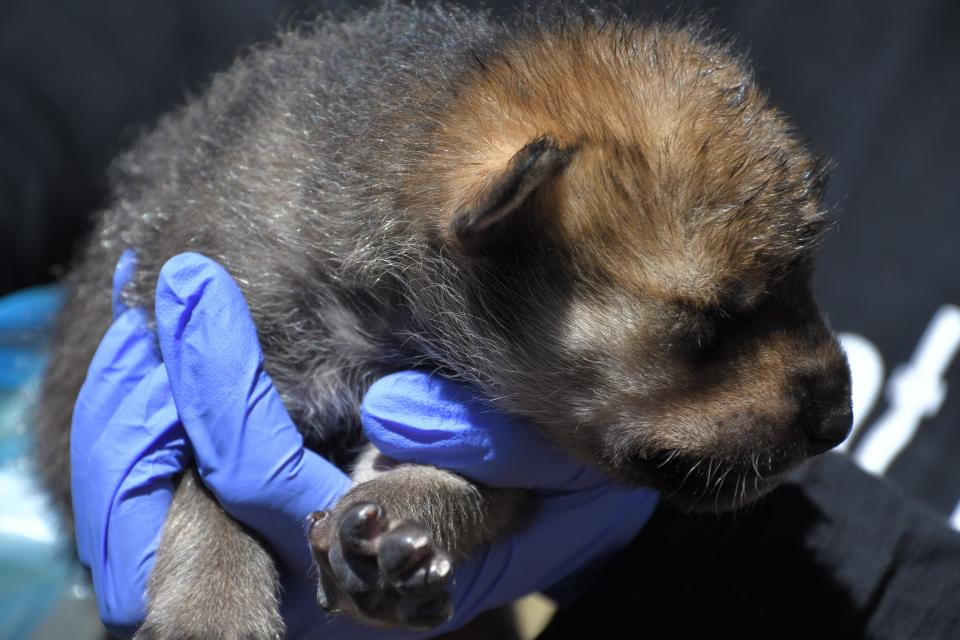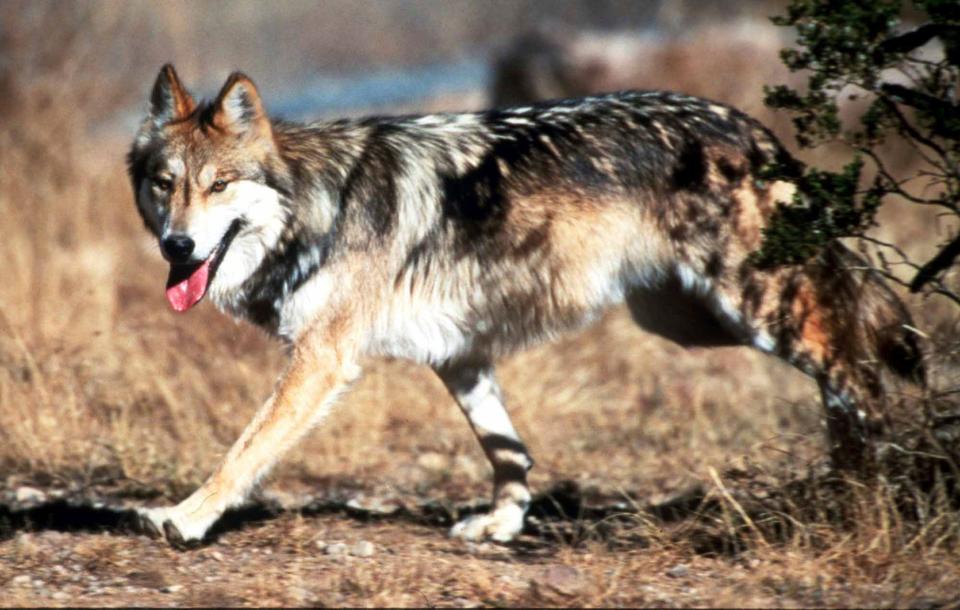Mexican wolf pups sent to New Mexico to breed, increase genetic diversity
A group of Mexican wolf pups were sent to dens in New Mexico this spring to begin repopulating the endangered species after a cap on its population was removed last month.
Pups born in captivity were expected to be raised by surrogate parents in their new dens and ultimately mate with intention of increasing genetic diversity of the species.
They were sent from zoos and conservation centers around the country to locations in southern New Mexico and eastern Arizona, a region identified by the U.S. Fish and Wildlife Service as breeding grounds for the animal.
The move came weeks after the Fish and Wildlife Service announced it removed a population cap of 325 wolves and signaled a growing effort to see the species’ numbers increase.
The 11 pups were being raised through the process of “cross-fostering” that sees them added to an existing family of wolves, relying on the mother’s maternal instincts to raise them and ensure survival to breeding age.
Introductions were conducted over a three-week period, with the Mexican Interagency Field Team reporting cross-fostered pups have the same 50 percent survival rates in their first year of life.
More: Funds on the way for New Mexico's endangered species through US Senate bill, grants

The project was conducted by the U.S. Fish and Wildlife Service as part of its Wolf Species Survival Plan to protect the Mexican gray wolf, listed as endangered in 1976, from extinction.
Presently, about 300 wolves survive in New Mexico and Arizona, while they once numbered in the thousands across the American West.
“The care, planning and teamwork that went into this year’s cross-fostering is remarkable,” said Ed Davis, biologist with the Fish and Wildlife Service. “Many contributed to the success of this year’s efforts, including interns, biologists, veterinarians, captive facility staff, and individuals that provided flight support.
"It will take all of us continuing to work together to achieve greater genetic diversity in the wild population.”
More: New Mexico ranchers take on national environmental group over protections for rare bird
Of the five dens wolves were introduced to, four were in New Mexico.
Three pups came from Chicago’s Brookfield Zoo to the Whitewater Canyon Pack near Gila National Forest in southwest New Mexico, while another two pups came from El Paso Zoo to the Iron Creek Pack also near Gila.
The Wolf Conservation Center in South Salem, New York also sent a pup to Iron Creek, and the Sevilleta National Wildlife Refuge in Socorro sent two pups to the Buzzard Peak Pack in Catron County.
More: Oil and gas threatens lizard native to southern New Mexico. Here's what's being done
The Southwest Wildlife Conservation Center in Scottsdale, Arizona sent a pair of pups to the Panther Creek Pack north of Phoenix.
In total, 83 pups were fostered by the program since it began, and plans are being made for more introductions next year.
Since cross-fostering began, the Fish and Wildlife Service reported at least 13 pups survived two years in the wild and reached breeding age, with four reproducing and seven litters from cross-fostered pups documented through 2021.
More: Delay on federal protections for native southeast New Mexico flower prompts lawsuit
This spring, the Field Team reported it observed denning behavior by three 2-year old cross-fostered wolves breeding for the first time this year.
Packs are monitored via global position system (GPS) technology, radio collars and remote cameras.

At the end of 2021, 196 Mexican wolves were reportedly living in the wild in the population area stretching from eastern Arizona to southwest New Mexico – a 5 percent increase from the 186 wolves documented at the end of 2020.
More: Mountain butterfly in New Mexico could see federal protections from extinction
Records show this marked the sixth year in a row of population growth and represents a doubling in wolf numbers since 2015.
Jim deVos, Mexican wolf coordinator at the Arizona Department of Game and Fish said the pups would help increase genetic diversity among the species, a key aspect of preventing the Mexican wolf from dying out.
He said he hoped more wolves would be fostered through the program.
“Although the 11 pups fostered is lower than hoped for, it is a major contribution to managing genetic improvements in the wild population,” deVos said. “Planning has already begun for the 2023 fostering program, with a goal of getting more pups in dens next year than this year.”
More: Ted Turner-owned land in southern New Mexico conserved in federal military deal
But cross-fostering drew criticism from conservation and environmental groups who called on the Fish and Wildlife Service to focus on raising full dens in captivity before releasing in the wild.
This would ensure wolves were bonded, argued Michael Robinson at the Center for Biological Diversity, and support true genetic diversity.
“It’s disappointing that the federal government still refuses to replenish the priceless genetic diversity lost through its own mismanagement of these wolves,” he said.
Chris Smith, southwest wildlife advocate at Santa Fe-based WildEarth Guardians criticized the agency for doing the “minimum” in protecting the wolf and said the “best science” should be used in the efforts.
“Sadly, it has become the norm for this program to ignore the best science and public support for actual, robust wolf recovery and instead opt for the minimum,” he said.
Adrian Hedden can be reached at 575-628-5516, achedden@currentargus.com or @AdrianHedden on Twitter.
Adrian Hedden can be reached at 575-628-5516, achedden@currentargus.com or @AdrianHedden on Twitter.
This article originally appeared on Carlsbad Current-Argus: Mexican wolf pups sent to New Mexico to breed for genetic diversity

